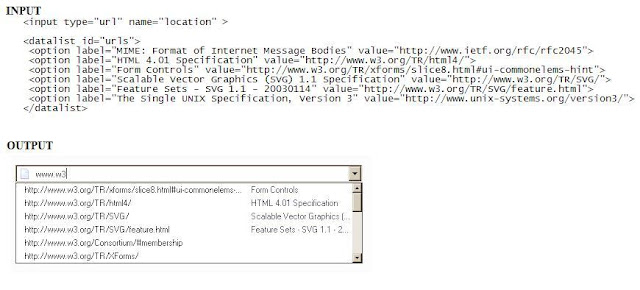Question:* What is Dijit?
Answer: • Dijit is Dojo’s UI Library.
Question:* AMD is an acronym for
Answer: • Asynchronous Module Definition
Question:* lang.replace("title/{home}/{page}", {home: "dojo", page:"1.8.1.0"}) produces what result?
Answer: • "title/dojo/1.8.1.0"
Question:* lang.replace("title/{home}/{page}", {home: "dojo", page:"1.8.1.0"}) produces what result?
Answer: • "title/dojo/1.8.1.0"
Question:* Which module provides enhancements to native Array functions which may not be available?
Answer: • dojo/_base/array
Question:* What does Dojo Util provide?
Answer: • Dojo Util contains utility scripts including build, shrink, test and documentation support
Question:* What does dojo/hash provide?
Answer: • Interface to the browser's URL hash
Question:* What are the two ways to add Dijit widgets?
Answer: • programmatically and declaratively
Question:* What server-side technology can Dojo work with?
Answer: • Dojo is a client-side, back-end agnostic technology that can be used in conjunction with ANY server-side technology.
Question:* What does dojo DojoX handle?
Answer: • Extensions and experimental code from the Dojo team and third party
Question:* What are the main packages of Dojo?
Answer: • Dojo, Dijit, DojoX, and util
Question:* In this code: require(["dojo/request"], function(request){ request("example.json", { handleAs: "json"}).then(function(data){ // Do something }) }); data is
Answer: • The content of the file example.json.
Question:* When should you use a built version of Dojo?
Answer: • A built version of Dojo should be used when you need to minimize the amount of code downloaded and the number of requests made.
Question:* What does the dojo/_base/declare module contain?
Answer: • dojo/_base/declare contains functions to define Dojo classes, which support standard Object Oriented concepts within Dojo.
Question:* How do you load Dojo on your HTML page?
Answer: • Include dojo.js
Question:* What is a dijit?
Answer: • A widget
Question:* Which code loads the dijit/form/Button module and waits until HTML has been loaded and processed?
Answer: • require(["dijit/form/Button", "dojo/domReady!"], function(Button) { // Do something });
Question:* What does dom.byId() return?
Answer: • Reference to the DOM element
Question:* What does Dojo Dijit provide?
Answer: • UI widgets
Question:* What is JSON?
Answer: • JavaScript Object Notation
Question:* What is dojo/store?
Answer: • dojo/store is an uniform interface for the access and manipulation of stored data.
Question:* How do you import a module? (in this case dojo/query)
Answer: • require(["dojo/query"], {});
Question:* When we create dijits programatically rather than declaratively we must ensure to?
Answer: • Call startup()
Question:* DojoX is
Answer: • DojoX is an area for development of extensions to the Dojo toolkit.
Question:* When does the function in require(["dojo/domReady!"], function() {}); execute?
Answer: • When the DOM has finished loading
Question:* To create a Dijit button widget, what module must be used?
Answer: • dijit/form/Button
Question:* To create a table with an Ajax interface to a server, you can use
Answer: • dojox/grid/DataGrid or dgrid
Question:* What function handles the call back feature?
Answer: • then()
Question:* What is one way to add a click handler to a button?
Answer: • on(button, "click", function(e){ // handle event });
Question:* What does registry.byId() return?
Answer: • Reference to the dijit
Question:* Which Dijit widget should be used to validate a telephone number? In this case a telephone number is defined as a string up to 16 characters, including digits, parentheses, dashes, periods, spaces and an upper or lower case x.
Answer: • dijit/form/ValidationTextBox
Question:* How do you use dojo/query to get all elements with class "foo"?
Answer: • query(".foo");
Question:* dojo/on is
Answer: • a general-purpose event handler module
Question:* What does lang.getObject("foo.bar") return?
Answer: • The bar property of foo
Question:* What is dojo/domReady! ?
Answer: • dojo/domReady! is an AMD loaded plugin that will wait until the DOM has finished loading before returning.
Question:* The annotation data-dojo-attach-point='foo' allows us to do what?
Answer: • Allow access to the DOM node by the widget
Question:* What do dijits not offer?
Answer: • Accessing data stores
Question:* What do compliant async functions return?
Answer: • Defered object
Question:* How do I query a store using complex criteria (month > 10)?
Answer: • dates.query(function(date){return date.getMonth() > 10});
Question:* How is JSON-P different than JSON?
Answer: • JSON-P works by making a <script> element (either in HTML markup or inserted into the DOM via JavaScript), which requests to a remote data service location.
Question:* What does dojo/has do?
Answer: • Check if the browser supports a feature
Question:* How does a function and it's call back behave?
Answer: • Run the function then invoke the call back
Question:* Why should you place the script tag that loads Dojo at the end of the document body?
Answer: • Because most pages have some HTML elements which must be ready for use before Dojo can run.
Question:* How do we access a dijit's properties?
Answer: • Extension points provided by the dijit
Question:* What is the _WidgetBase lifecycle?
Answer: • constructor > postscript > startup
Question:* What does lang.hitch() do?
Answer: • Call a function in the context of a widget
Question:* What is dojo/when used for?
Answer: • Handling both async and synchronous code
Question:* When invoking lang.mixin(y, x) what happens?
Answer: • Sources are processed left to right so all of x is added to y (with y's properties 'winning')
Question:* How do you bind a function to response to UI events?
Answer: • on()
Question:* How do we define an internationalisation nls file? (denoted NLSFILE)
Answer: • define(["dojo/i18n!NLSFILE"], funtion(nlsFile){});
Question:* What does AMD provide?
Answer: • Each module specifying its dependencies
Question:* What is the difference between a dijit/form/FilteringSelect and a dijit/form/ComboBox?
Answer: • The ComboBox allows you to enter a new option, one that is not listed.
Question:* Is there a CDN for Dojo?
Answer: • Yes.
Question:* Which Dojo module is used to make Ajax requests?
Answer: • dojo/request
Question:* How should Dijit widgets be styled?
Answer: • Dijit widgets should be styled using a Dijit Theme.
Question:* The build process compiles the Dojo JavaScript into Java for distribution.
Answer: • false
Question:* What does setting parseOnLoad to true do?


No comments:
Post a Comment